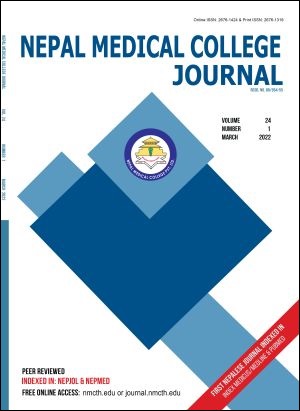Prevalence of Depression among Menopausal women in a rural community of Morang, Nepal
DOI:
https://doi.org/10.3126/nmcj.v24i1.44138Keywords:
Menopause, menopausal symptoms, depression, socio-demographic characteristicsAbstract
There is a great diversity in nature of menopausal symptoms and frequencies across countries, even in the same cultures. These symptoms could be unpleasant and disabling leading to depression in some menopausal women. Hence, this study was conducted to determine the prevalence of depression among menopausal women and to assess the association of menopausal symptoms with the socio-demographic variables. A cross sectional study was conducted in the Tankisinuwari area of Morang District. Total of 355 menopausal women were enrolled using systematic random sampling. The women were interviewed using semi-structured questionnaire. Depression was assessed according to Center for Epidemiological Studies Depression Scale (CES-D). Data analysis was done using SPSS 16 version. The majority of women 226 (63.7%) were illiterate and 226 (63.7%) of them were living below the poverty line. Mean age of menopause and (SD) was 46.81± 4.64 years. Prevalence of depression was found to be 31.5% (n=112). Among women belonging to Dalit caste, menopausal symptoms were more common as compared to other ethnic groups. Menopausal symptoms were experienced most frequently by women living below poverty line. The menopausal symptoms which was found to be significantly associated with literate women was complaints of irritability (p=0.023) whereas with illiterate women were sleep problem (p=0.045), decrease in sexual desire (p=0.012) and nocturia (p=0.041). Depression was significantly associated with low economic condition (p=0.011). As there is increase in the life expectancy and population of menopausal women in Nepal, large efforts are required to educate and make these women aware of menopausal symptoms. It is also important for health-care providers to understand the differences between cultures, so that appropriate advice can be given and treatment can be tailored according to the needs of the community, irrespective of the country.
Downloads
Downloads
Published
How to Cite
Issue
Section
License
Copyright (c) 2022 Nepal Medical College Journal

This work is licensed under a Creative Commons Attribution 4.0 International License.
This license enables reusers to distribute, remix, adapt, and build upon the material in any medium or format, so long as attribution is given to the creator. The license allows for commercial use.




